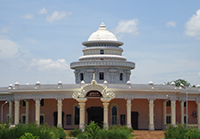Historical and Archaeological Heritage Management and Cultural Tourism in India and Japan: Issues, and Prospects for Development
Historical and Archaeological Heritage Management and Cultural Tourism in India and Japan: Issues, and Prospects for Development
ISBN: 978-93-5361-404-1
Published by:
Tamil University, Thanjavur, India
and
Kobe Yamate University, Kobe, Japan
2019
You can download the entire book or chapters by clicking on the links below.
All in One PDF
Cover Page
Front Pages
1. Introduction V.Selvakumar and Manabu Koiso – Page 1
6. Archaeological Heritage Management Issues in the Region of Western India M. Nambirajan – Page 95
7. Ethnic Tourism as Alternative Development in the Lower Omo Valley, Ethiopia Nishizaki Nobuko – Page 110
8. Conservation of Cultural Heritage and Tourism in Pakistan Atsushi Noguchi – Page 126
9. Conservation through Management: A Case Study of the World Heritage Site of Bhimbetka S.B. Ota – Page 159
10. Need for a Subaltern Approach to Archaeological Record in India K.Paddayya – Page 108
13. Management of Epigraphical heritage as gleaned from the Medieval inscriptions S. Rajavelu – Page 220
14. Approaches to Heritage Management: Application of Traditional Methodology T. Satyamurthy – Page 230
15. Archaeological Heritage Management in India: Current Status, Issues and Prospects V. Selvakumar – Page 248
16. The Digital Historical Atlas of South India Project and Heritage Management Y. Subbarayalu – Page 296
18. Heritage Management in India and the USA: Comparative Perspectives S.Suresh – Page 317
20. Heritage Walk Trivandrum Elizabeth (Bina) Thomas - Page 352
21. Archaeological Heritage Management in Japan TomokatsuUozu- Page 354
22. Bharathanatyam: A Glorious Spiritual Heritage A. Vadivudevi – Page 372
Resolutions and Suggestions of the Symposium - Page 401
Photo Gallery – Page 406
Glossary – Page 408
Contributors – Page 414
Symposium Organising Committee – Page 423










